Recovery Times After Carpal Tunnel Surgery
EVERYTHING YOU NEED TO KNOW
People often hear that Carpal Tunnel Surgery is quick and easy to perform, implying that it is no big deal. From a surgeon’s perspective, that is true.
A Carpal Tunnel Release Surgical Procedure generally takes less than 30 minutes and the incision does not need to penetrate deep into the body to sever the Transverse Carpal Ligament.
For a Surgeon, it is one of the simplest procedures to perform. It can be done as an “out-patient” procedure, so you do not have to spend the night in the hospital. From that perspective, it is relatively simple.
However, from a patient’s perspective, you might say not so fast.

What are the recovery times after Carpal Tunnel Surgery?
- Patients find a wide variety of recovery times depending on many different factors.
- Successful Surgeons, by nature, need to be optimistic and tend to focus on positive outcomes when talking to patients prior to surgery. There are a lot of negative potential complications with any surgical procedure and Carpal Tunnel Syndrome is no exception to this rule. With only a 50 – 60 % success rate in patient surveys for first time Carpal Tunnel Operations, it is important to understand the potential complications. Carpal Tunnel Surgery does not always go according to the planned optimistic point of view.
- Since there are an infinite number of outcomes and recovery times of Carpal Tunnel Surgery. However, to keep the discussion simple, we will deal with the subject in three sections in a scientific statistical manner.
- Best Case Recovery Scenarios about 16% of patients
- Typical Recovery Scenarios about 68% of Patients
- Worst Case Scenarios about 16% of Patients
- These scenarios follow a typical bell curve distribution or normal distribution as illustrated in this graph.
What are the recovery times after Carpal Tunnel Surgery?
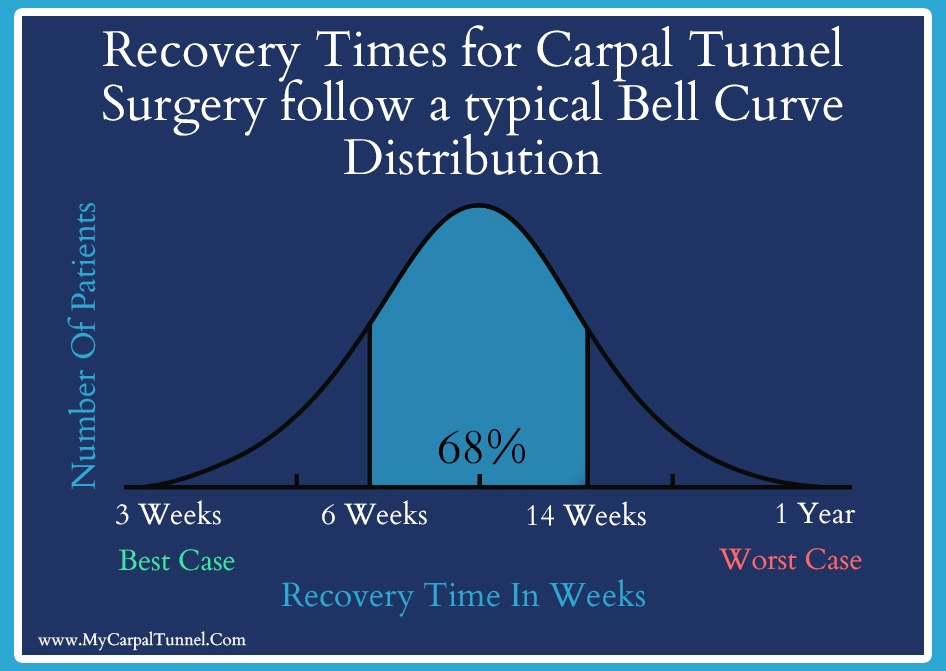
What is the average carpal tunnel surgery recovery time?
-
In brief, full recovery from Carpal Tunnel Surgery can take six weeks to over a year. It can involve a lot of visits to a physical therapist for rehabilitation over the course of that time frame. This is a broad time frame and depends on many factors. Some of the factors include the unpredictable formation of scar tissue.
The Transverse Carpal Ligament is severed during surgery. It has be likened to a nylon rope and is the strongest ligament holding the bones and muscles of the hand together in a compact and functional manner.
Once it is severed hand strength is completely compromised until it heals back together. As with most parts of the body, it is less strong and functional after it has been severed and scars back together.
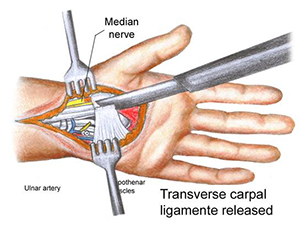
- Most patients (about 68%) find it difficult to do much, if any, activity for the first two to three weeks. They experience significant pain and swelling and some lingering symptoms of Carpal Tunnel. The worst symptoms of Carpal Tunnel usually go away immediately because one of the walls of the Carpal Tunnel, the transverse Carpal Ligament has been severed and must scar back together during the healing period.
- Some symptoms may be masked by the more intense pain of the trauma from surgery in the first 10 days, so it can be difficult to judge success of the procedure until the pain from the trauma of surgery has subsided. Fortunately, the mind can only focus one intense pain source at a time and therefore does not recognize less painful symptoms when present with more intense discomfort. Oral Pain Medication and antibiotics should be prescribed to deal with the pain and prevent infection.
- Be patient healing from the trauma of Carpal Tunnel Surgery takes time. Don’t rush the process.
- Patients typically begin to recover some function within three weeks and are generally fully functional within 6 weeks to 12 weeks after Surgery if they follow the physical therapy guidelines provided.
- Some patients in this group get completely better and resume their activities of their life before Carpal Tunnel without any limitations and are glad they had the procedure done, even though it took a little longer than expected to recover and the rehab was more intense than they had expected. They are relieved and happy about the result and are glad they got the problem fixed.
- What most people don’t realize, at this point, is that Carpal Tunnel Surgery is not a permanent fix for CTS. It is a reoccurring syndrome that comes back for over 90% of people even after a successful surgery. CTS reoccurs for most within a period of between one year – up to ten years. Patients think everything hunky dory until the Carpal Tunnel Symptoms return.
- Some of the patients in this category will find they have lingering symptoms of Carpal Tunnel. Their worst symptoms will be gone and they can function well, but they often have lingering numbness in the finger tips or tenderness at the point of incision or permanent loss of grip strength. Surgeons claim that the surgery was a success because the worst symptoms of Carpal Tunnel were eliminated, but from the patient’s perspective, it is a bit of a surprise to find that they still have some lingering symptoms even after several months have passed since the surgical procedure was performed. These lingering symptoms are annoying, but these symptoms do not prevent normal function, they are just annoying to deal with.
What is the average carpal tunnel surgery recovery time?
Typical Carpal Tunnel Operation Recovery Time Scenarios
Am I at risk for a longer recovery time?
- Patients often ask, “Is there anything I can do to improve my recovery time?”
- Factors that can increase your recovery time from Carpal Tunnel Surgery and what you can do to improve your chances for a rapid recovery with no complications:
- Failure to wash with Chlorihexidiene Gluconate (CHG)for two days prior to surgical procedure. You can obtain CHG from your local pharmacy. It does not require a prescription.
- Extended period on Narcotic Pain Medication slows recovery – Get off pain medication as soon as you can. It will slow recovery and has serious side effects, including addiction.
- Failure to take Oral Antibiotics as indicated in post-operative prescription. Sometimes surgeons do not prescribe antibiotics after Carpal Tunnel Surgery. This is a mistake and each patient should insist on an antibiotic prescription to be filled prior to the surgical procedure, so that you have it when you are incapacitated after the surgery.
- Poor Hygiene of the area around the surgical incision post-surgery.
- Allowing the wound dressing to get wet and then not changing it out.
- Prior Exposure to Corticosteroid Injection within the previous 3 – 6 months. This is another good reason not to get a Steroid Injection to treat Carpal Tunnel, because it can cause more slow recovery rates and a predisposition for infection post-operation.
- Going back to work too soon after Carpal Tunnel Surgery
- Driving before your stitches have been removed
- Too long on anesthesia during operation due to complications
- Smoking can dampen the Body’s Immune System and slow recovery
- Post-Surgical Anxiety – Unexplained anxiousness, fear and worry
- Obesity Slows Recovery from any surgical procedure.
- Poor Nutrition Prior to Surgery and after surgery.
- Failure to follow Post-operation physical therapy protocol – Make sure the surgeon prescribes Physical Therapy so your insurance will cover the cost prior to the surgical procedure.
- Extreme Compression of the Median Nerve for many years prior to surgery can leave the nerve with permanent damage. This is rare, but it can happen.
- Exposure to antibiotic resistant bacteria on the skin or on the surgical equipment or operating table.
- Poor control of Diabetes blood sugar levels Prior to Surgery.
- Age will increase your risks of complications and slower recovery. The older you are the slower the recovery and the higher the chance of complications and infections.
Am I at risk for a longer recovery time?
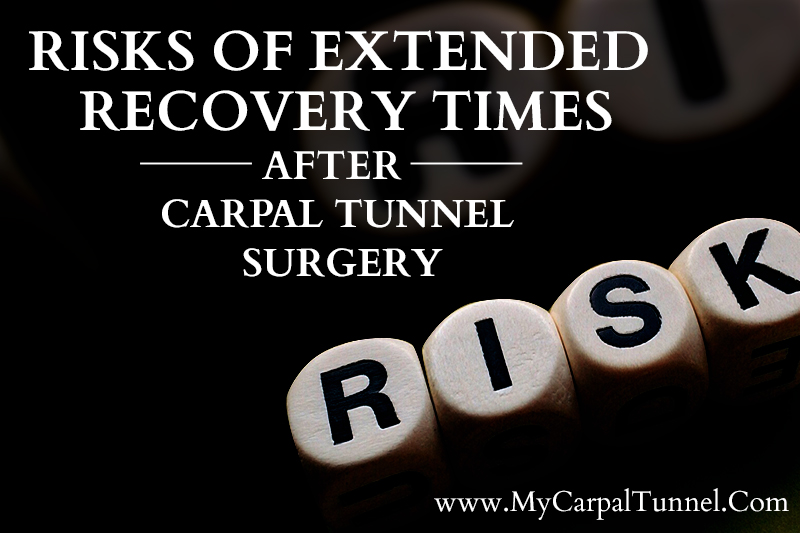
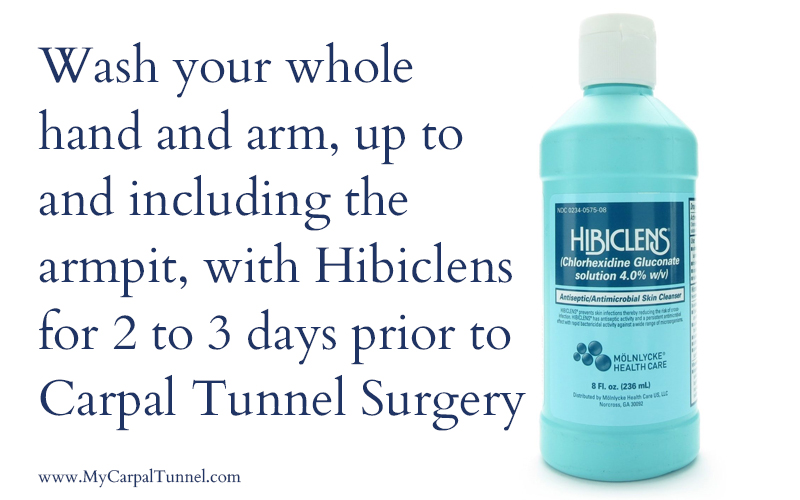

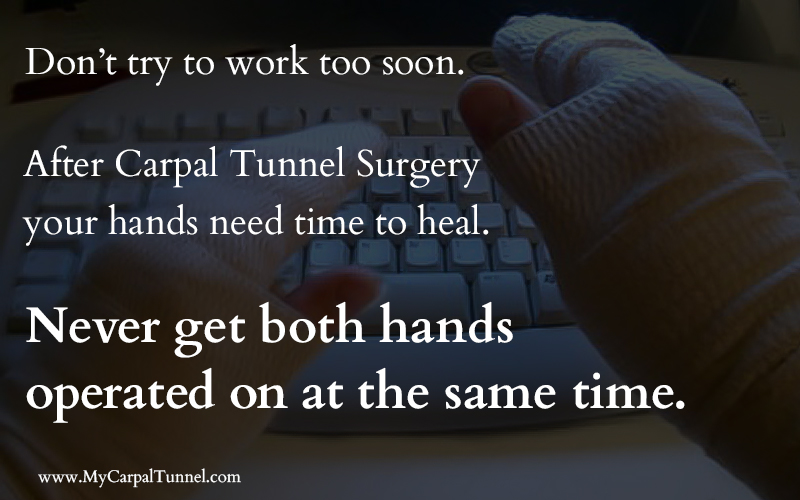
What are the chances of full recovery?
- In best case scenarios patients have no complications and immediately find relief of all of their Carpal Tunnel Symptoms.
- These patients do experience a lot of pain during the first 7 to 10 days from the trauma of surgery. The initial pain from surgery is managed with oral pain medical prescribed by your Doctor. The prescription for pain medical should be filled immediately prior to the surgery by yourself or immediately after the surgery by a friend or loved one, so you have it when the anesthetic wears off. Also, as a precaution most surgeons prescribe an antibiotic oral medication to guard against the potential for infection. This prescription should begin immediately after the surgery.
- In best case scenarios patients begin doing things with their hands within a week or two and are fully functional for normal activities within three to six weeks. Still, even though you might be feeling ready, care should be taken not to overdo it with intense activity with your hand until after 8 weeks to 10 weeks. Healing from the trauma of surgery takes time.
- All patients should begin physical therapy and follow the recommendations of the expert physical therapist in deciding which activities are appropriate and how much is too much. The appropriate movement can help accelerate your recovery while the wrong kind of activities, too soon, can cause more scar tissue to form.
- It can be helpful to accelerate your recovery to elevate the hand while resting to facilitate the dispersion of inflammation and apply icing strategies after the first couple of days under the direction of the physical therapist. Your body’s natural healing process is faster when swelling and inflammation are controlled. Anti-inflammatory medication can help, but for no more than 10 days in most cases, always as directed by your Doctor or Therapist. All Anti-Inflammatory medication have side effects with long term use and should not be used more than 10 days without a Doctor’s recommendation and monitoring.
- It is never pleasant to focus on the worst-case scenarios people can experience with Carpal Tunnel Surgery, however, with any surgical procedure you want to go into it with your eyes wide open, knowing the downside of what could potentially happen. It is good to know how to mitigate the negative aspects, if possible, or reconsider the course of action given the potential consequences.
- Then seek an alternative treatment method for Carpal Tunnel option with less serious consequences and quicker recovery times and a better overall prognosis. Learn more about your option in under Treatment in the top navigation bar.
- So, the worst-case scenario is your symptoms can become much worse post-surgery due to the formation of scar tissue after the procedure which puts more pressure on the Median Nerve after surgery than was experienced before.
- Soft tissue always forms some scar tissue when it is severed and heals. There is no way to be sure how much scar tissue will form during the healing process after surgery. People with certain conditions, like severe arthritis, generally experience more potential for scar tissue formation and are at the highest risks for a negative outcome from surgery.
- Other Worst-Case Scenarios would include those people who do not see any improvement from their symptoms.
- Some people get partial improvement of their symptoms, but still experience Carpal Tunnel Symptoms that inhibit their ability to sleep work and function normally.
- Whatever the patients circumstances, in this category people are very disappointed to go through so much trauma, downtime and risks only to have disabling hand symptoms preventing enjoyment and full functionality. It can be depressing when all the surgeon can do is shrug and say I can’t do any more except a second surgery. A patient would have to have a screw loose to agree to a second surgery under these circumstances.
Best Case Operation Recovery Time Scenarios

Worst Case Recovery Time Scenarios from Carpal Tunnel Surgery
How long does pain last after carpal tunnel surgery?
- As with most aspects of a traumatic surgical procedure, the length of time a patient experiences pain can vary widely. As you probably know there are two types of surgical procedures for Carpal Tunnel Release:
- The Open Carpal Tunnel Release Procedure is the most widely performed (Open Procedure) and
- The Endoscopic Carpal Tunnel Release Procedure which is less invasive. (Endoscopic Procedure)
- In the Open Procedure it is important to understand that significant soft tissue must be cut and disrupted for the surgeon to get access to the Transverse Carpal Ligament, which is severed during surgery. Severing the ligament releases the pressure on the Median Nerve. It takes time for this tissue to heal and for the severed ligament to scar back together and it can be painful for several weeks. However, the Open Procedure carries less risk of incidental injury to tendons or to the Median Nerve itself, since the surgeon can see clearly with his eyes and move obstructions out of his way freely.
- With the Endoscopic Carpal Tunnel Procedure, less collateral tissue is disturbed, which is a good thing. However, there are challenges and risks of maneuvering a scalpel in such a tight space as the Carpal Tunnel with limited visibility using a monitor fed through a remote camera. Cutting a ligament that is so close in proximity to nerves, tendons, blood vessels, etc. with a remote monitor where visibility is limited is a challenging operation.
- Important tissue can be inadvertently damaged with even the lightest touch of the scalpel with the Endoscopic Procedure. The tolerances are measured in millimeters, where the ligament ends and the nerve or tendons begin. If the Median Nerve is accidentally nicked with the scalpel, there can be permanent damage done to the nerve that will cause pain for years and even decades after the procedure. So, there are trade-offs with risks, healing time, and the gravity of potential complications.
- If all goes well, there is less collateral damage with the Endoscopic Procedure and recovery times and post-surgical pain are generally shorter in duration, usually measured in a range of 3 – 4 weeks as a best-case scenario. So, if you are comfortable with the Surgeon’s track record with Endoscopic Carpal tunnel Surgery, a case could be made for the Endoscopic Procedure.
- Infections only occur in 1 – 3% of surgeries. However, when surgical site infections do occur, the complications and the pain can be intense, causing week long stays in an ICU and even threaten life if not dealt with correctly and with a strong sense of urgency. Infections have a geometric rate of progression as opposed to a linear rate of progression. This means they have the potential to double in size every few hours. This is why it is so important to stay ahead of the curve with a surgically caused infection. If an infection does occur, it is most likely to happen within the first 30 days after a surgical procedure.
- There are certain factors that can predispose a person to having a higher probability of infection post-surgery. One key factor is “Steroid Exposure” prior to surgery. Since Steroid Injections are considered standard treatment for Carpal Tunnel to try to prevent the need for surgery, many people with CTS have a higher predisposition to infection because of the Corticosteroid Injections they were given by the surgeon a few months prior to surgery
- It is ironic that in an attempt to avert surgery with steroid injections, that surgeons actually create a higher risk of infection when surgery is finally performed. Other factors that predispose a person to a surgical site infection include: Obesity, Poor Nutrition, Poor Hygiene, Tabaco Use, Diabetes, and Compromised Immunity.
- Also, despite all the procedures to sterilize surgical equipment and operating rooms, microbes cannot be seen with the naked eye and micro flora almost always finds a way to survive and thrive even in the cleanest of environments. Prescribing oral antibiotics for the patient is an important part of infection prevention in the post-operation procedure.
- This simple oral prescription can make up for a multitude of errors in the prevention and containment of post-surgical site infections (SSI). Onset of an SSI is estimated to result in a hospital stay of 7 to 10 days on average and add over $3,000 in costs of post-operational care. Painful recovery times can be extended by months and permanent damage of tissue incurred, even amputation can be required when infection happens. Infections are just as likely with both types of surgical procedures.
- Infection is one worst case scenario which can be mitigated usually with antibiotics, good hygiene and sterile surgical procedures.
- Another worst-case scenario is when the Median Nerve or the Ulnar Nerve is inadvertently touched with the scalpel in the procedure. A damaged nerve could lead to a life time of pain and lack of full-function of the fingers or thumb.
- So, the question of how long does pain last after Carpal Tunnel Surgery is somewhat complicated and depends on so many factors, but let us deal with what is typical for each procedure.
- If all goes well (no complications), then most patients experience intense pain while resting and increased discomfort with movement for the first 10 to 14 days. This pain is mitigated effectively by oral pain medication which your surgeon should prescribe for you before you undergo the surgical procedure, so you have it on hand when you are incapacitated and the pain kicks in high gear. However, there are serious side effects of all narcotics and serious pain medication. The patient should try to limit her or his exposure to these powerful and potentially addictive medications as soon as is possible once the discomfort is tolerable.
- The surgeon should also prescribe a base line oral antibiotic medication before the procedure, to assure that any chance of infection is stomped out before it can get started.
- Why did my Surgeon tell me that I would recover within two three weeks from Carpal Tunnel Surgery?
It then took me over 3 months to get back to a point where I could work and I seem to have permanent lack of grip strength, tenderness and scare tissue where I was cut. I did not expect to have to deal with all of this.
Sam
Ames, Iowa - Successful surgeons are optimistic by Nature and almost always focus on the best-case scenarios when describing what patients can expect. If they allowed themselves to focus on the negative outcomes or the worst-case outcomes, they would not be able to keep up in the morning and function. You want to have a positive and optimistic surgeon if you are undergoing surgery of any kind. It is a healthy place to be, when you are positive things almost always go better.
For a patient, however, it is important to go into any surgical procedure with your eyes wide open. You need to be ready for anything that could happen and prepare for the worst so, that you are pleasantly surprised when things go better and you are ready for whatever happens. You want to be optimistic, but prepared for what could happen. For instance, if you insist on an antibiotic prescription before surgery and maintain thorough hygiene, avoid steroids, avoid smoking, exercise and keep your immune system at its peak prior to surgery; you have a better chance of having no infection and a more rapid recovery.
How long does pain last after carpal tunnel surgery?
Best Case Scenario

Worst Case Scenario – Infections Extend Post-Operational Pain Duration Significantly
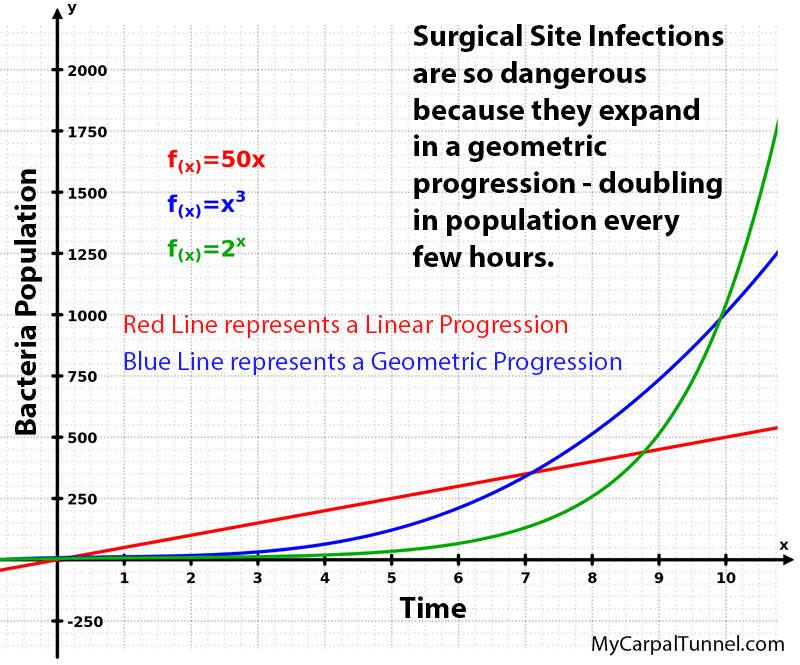
It is important to keep in mind that there are several worst-case scenarios:
The Typical Experience of a Patient without Complications
Open Surgical Procedure
Patient Question:
Answers by Doctors at First Hand Medical:
The limitations of carpal tunnel surgery
- A “full recovery” may not be in the cards for every patient. For example, it is common to have permanent loss of grip strength.
- So, opening a jar, gripping a golf club, or holding garden tools firmly for digging might be compromised permanently.
- Also, patients commonly report long-term tenderness at the point of incision, making it somewhat uncomfortable to ride a bike, gripping the handle bars. It can be difficult to grip a ski pole firmly for a secure pole plant on the ski slopes. You can also lose comfortable range of motion due to the formation of scar tissue. These effects are often permanent.
- All in all, surgery is not to be taken lightly from a patient’s perspective. Surgery has to be repeated in about 85% of cases within seven years because it is not a permanent fix. You can learn more about the potential risks on this website under the title: Risks and Complications of Carpal Tunnel Surgery.
The limitations of carpal tunnel surgery

What is the cost of surgery?
-
How does The Carpal Solution compare to surgery?
Surgery
$0Cost without Insurance0%Success Rate0days+Wait time for treatmentThe Carpal Solution
$0Cost without Insurance0%Success Rate0daysWait time for treatment
Choosing the right surgeon
-
You should avoid surgery if you can, but if you feel that you have exhausted all clinically documented treatments, and need to resort to surgery on your hand, you should pick a good surgeon with a strong track record and schedule sufficient downtime for full recovery.
It would also be wise to line up someone who can lend you a hand when needed during recovery. Handicapped people or caregivers taking care of a loved one, find it particularly difficult to line up the support.

- If your symptoms do not go away after two or three months post-surgery, or you have new symptoms you did not have before surgery, you should visit the specialist to see what is going on with your hand. Patient survey’s give surgery a 50 to 60% success rate, so it is not unusual to have after effects and a long recovery period.
Choosing the right surgeon
How long does carpal tunnel surgery last?
- Carpal tunnel surgery is an outpatient procedure. Meaning that you will have the operation and go home that same day.
- This means you will not need to bring an overnight bag or make arrangements from being away from home, depending on the location of the surgery.
- The duration of the actual carpal tunnel surgery is typically around 10 minutes.
How long does carpal tunnel surgery last?

What are the potential complications that could happen with Surgery?
- The Transverse Carpal Ligament – the largest and strongest ligament in the hand wrist area – is severed during Carpal Tunnel Surgery to relieve pressure on the Median Nerve.
- Specific risks and complications that could arise from such a surgery include:
- Permanent loss of grip strength is common with Carpal Tunnel Surgery.
- Permanent Tenderness at the point of incision is also common.
- Some people experience permanent loss of Hand Dexterity and Fine Motor Skills.
- Extended rehab periods are common. Rehabilitation runs from six weeks to over a year for some patients to regain functionality of their hands and wrists.
- Scar Tissue Development which can increase pressure on the nerve and make CTS worse after surgery than it was before.
- Permanent Nerve Damage can occur if the scalpel touches the Median Nerve which runs just under the Transverse Carpal Ligament, causing permanent nerve damage. Damage to the tendons, muscles and other soft tissue that run just under the Transverse Carpal Ligament.
- The need for a repeat surgery even after a successful Carpal Tunnel Surgical Procedure, because there is no permanent fix for Carpal Tunnel Syndrome. Second surgeries with any surgical procedure carry much more risks and are more complicated to perform due to scar tissue formation and loss of structural strength of the surrounding tissue from the original surgery.
Specific Risks of Carpal Tunnel Surgery:

What to expect after surgery
- For several weeks following surgery, the hand has to be bandaged in such a way to restrict movement and minimize scar tissue development. It is important to allow the healing to go undisturbed.
The stitches can usually be removed at: 2 ½ to 4 weeks. However, the healing continues under the skin for at least six weeks and up to eight weeks.
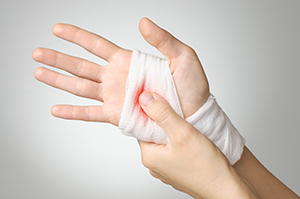
The tendons that control the movement of your hand and fingers all run through the Carpal Tunnel proximate to the Median Nerve. This is one of the reasons hand movement should be kept to a minimum during the early weeks of recovery after the procedure. Re-injury is not pleasant and can lead to significant scar tissue development.
What to expect after surgery
What are the potential complications from Carpal Tunnel Surgery?
- Hypertrophic scars
- Dysesthesias
- Joint stiffness
- Neuromas of the dorsal sensory branch of the radial nerve
- Failure to relieve symptoms
- Permanent loss of grip strength is common with Carpal Tunnel Surgery.
- Permanent Tenderness at the point of incision is also common.
- Some people experience permanent loss of Hand Dexterity and Fine Motor Skills.
- Extended rehab periods are common. Rehabilitation runs from six weeks to over a year for some patients to regain functionality of their hands and wrists.
- Scar Tissue Development which can increase pressure on the nerve and make CTS worse after surgery than it was before.
- Permanent Nerve Damage can occur if the scalpel touches the Median Nerve which runs just under the Transverse Carpal Ligament, causing permanent nerve damage. Damage to the tendons, muscles and other soft tissue that run just under the Transverse Carpal Ligament.
- The need for a repeat surgery even after a successful Carpal Tunnel Surgical Procedure, because there is no permanent fix for Carpal Tunnel Syndrome. Second surgeries with any surgical procedure carry much more risks and are more complicated to perform due to scar tissue formation and loss of structural strength of the surrounding tissue from the original surgery.
- Reactions to Anesthesia
- Infection
- Blood Clots that lead to Strokes, Heart Attacks, Deep Vein Thrombosis, Pulmonary embolism, Lung Damage
- Excessive Bleeding which can require blood Transfusions resulting in blood pressure cycling and stress on the heart.
- Reference: https://thejns.org/view/journals/j-neurosurg/62/3/article-p352.xml
The potential complications from the hand operation
The Transverse Carpal Ligament – the largest and strongest ligament in the hand wrist area – is severed during Carpal Tunnel Surgery to relieve pressure on the Median Nerve. This invasive surgical procedure has certain risks involved that a patient needs to be aware of going into surgery.
A study by Louis DS, Greene TL, and Noellert RC, found that neuroma of the palmar cutaneous branch of the median nerve was the most common complication of Carpal Tunnel Surgery.
Other complications also noted in this study were:
But the complications found in this study do not cover the full scope of the risks.
The following have also been documented as potential complications from Carpal Tunnel Surgery:
If you begin to experience any of these complications, it is essential that you contact your medical professional immediatley.
Summary of complications From Carpal Tunnel Surgery requiring 52 reoperations over a 12 year study
| Complications From Carpal Tunnel Surgery | % of Total Complications | Subsequent Reoperations |
| palmar cutaneous neuromas | 54% | 100% |
| hypertrophic scars | 12% | 100% |
| dysesthesias after multiple releases | 12% | 200% |
| stiffness | 7.4% | 0 |
| failure to relieve symptoms | 7.4% | 2 |
| radial sensory neuroma | 7.2% | 50% |
Potential risks From any invasive treatment such as Carpal Tunnel Surgery

How long does the carpal tunnel surgery incision take to heal?
- With the open Carpal Tunnel Surgical Procedure, if everything is handled properly, it should take about 10 days to 15 days for the skin to heal over the wound. However, even after the skin has healed the major muscle groups of the hand and the Transverse Carpal Ligament are still healing below the skin surface. Generally, the stiches can be removed as soon as the skin as healed back together and there is no sign of infection.
- As mentioned above a patient should not rush to return to full activity too soon, even after the stiches have been removed. The Transverse Carpal Ligament and major muscle groups of the hand are still scaring back together post-operation under the incision for up to 3 months. Strenuous activity with the hands should be avoided until after three months of low activity healing time.
- If there are complications, such as an infection or a reaction to anesthesia the healing period of the incision and the muscles and ligaments beneath will take significantly longer to heal. Once the complication is completely mitigated then the healing can take up to three to six months after a major complication. With complications, scar tissue is often dramatically increased causing a lot of potential side effects.
- It is extremely important to follow the pre-operation and post-operation protocols for the patient to assure that there are no preventable complications from happening. The rest is up to the cleanliness and sanitation techniques of the surgeon and his team and the people prepping the operating room.
- What are the Risks and potential complications with Carpal Tunnel Surgery?
- Does Carpal Tunnel Surgery Cause Scar Tissue?
- What are the risks of infection with Carpal Tunnel Surgery?
- Does Carpal Tunnel Pain ever get worse after surgery?
- Does Carpal Tunnel Return After Surgery?
How long does the carpal tunnel surgery incision take to heal?
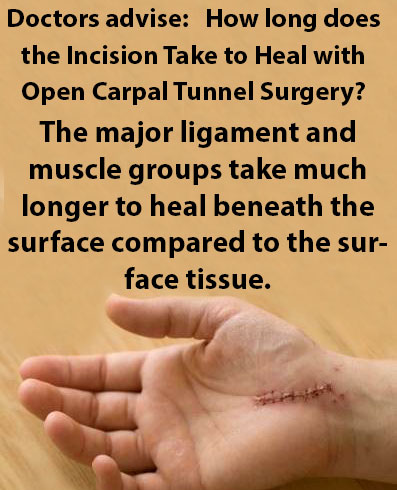
Other related subjects Patients often ask about Carpal Tunnel Surgery Healing:
Does Carpal Tunnel Surgery Fail? What Treatment then?
- This subject failure of a Carpal Tunnel Operation is not talked about a lot in the medical literature. This is understandable, because the medical literature is mostly written and controlled by surgeons who do not like to focus on the failure of one of the most performed surgeries in the world: The Carpal Tunnel Release Procedure.
- However, the reality is Carpal Tunnel Surgery does fail for a high percentage of people.An important question is how to define failure. While a surgeon may not agree with the definition provided here. We at First Hand Medical look through the eyes of the patient and adopt and represent the patient’s point of view when it comes to diagnosing and treatment of Carpal Tunnel Syndrome.
- So, Failure of Carpal Tunnel Surgical Release would be defined from a patient’s point of view as follows:
- 1- Carpal Tunnel Symptoms became worse after Carpal Tunnel Surgery (affecting between three and seven percent of patients).
- 2- Some of the Symptoms improved with surgery, but symptoms remained distracting enough to cause the patient to define the procedure as a failure overall. In other words, had the patient known the result before the surgery, they would not have opted to have the Carpal Tunnel Surgical Procedure. This affects about ten to fifteen percent of patients.
- 3- The symptoms went away for a few years, but came back as bad or worse as before within 1 year to 8 years. Some of these patients would have defined the surgery as successful if asked before their symptoms came back. However, when they realize the surgery was not a permanent fix, the patients report that they would not have agreed to have had the surgical procedure done, knowing it was only going to reoccur within a few years. This affects between 70 and 85% of patients. Of those patients who have experienced complete relief of their symptoms post-surgery, CTS comes back for over 90% within 10 years.
- So, for the majority of patients Carpal Tunnel Release surgery is a failure most of the time. There are some cases where patients go for 25 years with no reoccurrence of their symptoms. This represents about 8 – 10% of patients.
- In the long run most patients consider their Carpal Tunnel Operation a failure.
- Again keep in mind this is from a patient’s point of view. There will be many surgeons who strongly disagree with this statement, but the facts are the facts and we will stay true to our mission to represent the patient’s point of view in the diagnosis and treatment of Carpal Tunnel Syndrome.
- These are the odds you are facing with a Carpal Tunnel Operation. If you like these odds you should go forward with confidence after you find the best hand surgeon in your area. If you do not like these odds, there are better treatment methods developed by Doctors that work for over 97% of patients and do not carry any of the risks of infection, months of downtime and a long rehabilitation period.
- Learn what you need to know about Carpal Tunnel Treatment options that will allow you to avoid the risks, downtime and repeated surgical procedures.
- Don’t lose hope. There are good treatment Options even after a failed Carpal Tunnel Surgical Procedure. Learn More About Treatment After Failed Carpal Tunnel Surgery
- Learn what You Need to Know About the Treatment of Carpal Tunnel Syndrome
- Doctors’ Reviews of Treatment Options
Does Carpal Tunnel Surgery Fail?
The Facts May Surprise You.
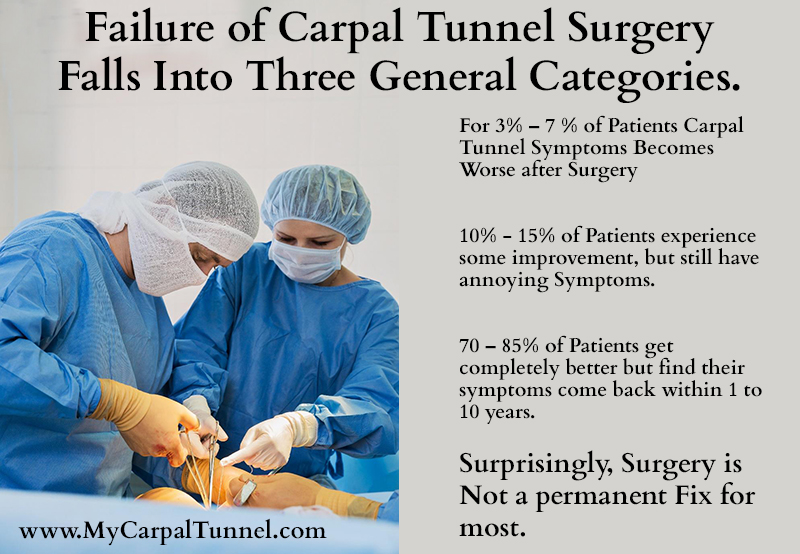

Carpal Tunnel Treatment Options That Allow a Patient to Avoid Carpal Tunnel Surgery.
Watch Videos of Real People Telling their experience with Carpal Tunnel Surgery.
Advice from people who have had surgery
Driving after carpal tunnel surgery
- It is advised that you should not drive at least 2 weeks after surgery. Your hands will be experiencing sensitivity and potentially some pain, and this will limit your ability to operate a vehicle confidently.
- Here are additional considerations you should take before getting behind the wheel post carpal tunnel surgery.
- Type of car: If you drive a manual car this will put more strain on your hands and could loosen stitches and even open up the wound.
- Medication: You will most likely be taking pain medication after your surgery. These medications can dull your concentration and reaction times. DO NOT attempt to drive whilst on such medications for the safety of yourself and others on the road.
- Insurance: Your insurance provider may not offer coverage after a surgical operation. Please contact your insurance provider before you attempt to get behind the wheel.
How soon can you drive after carpal tunnel surgery?

Considerations for driving after surgery
Carpal tunnel surgery recovery and time off work
- Job Type: Desk-based workers were able to return to work faster than non-desk-based-workers.
- Anxiety in response to pain and catastrophic thinking:Anxiety and other symptoms of depression post-surgery have been proven to extend the recovery period of patients undergoing all types of surgery.
- Recovery expectations: Expectations at either end of the recovery time spectrum have been shown to have a psychological impact on recovery times. Patients may mentally prepare for a year or more in recovery, where as others would presume days, therefore increasing their chance of damaging the healing process.
- Supervisory/Managerial: 1-2 Weeks
- Light Manual (clerical/secretarial): 2-4 weeks
- Medium Manual (cleaner/nurse/cashier): 4-6 weeks
- Heavy Manual: 6-10 Weeks
- Custodial/rescue Services: 6-10 Weeks
- No matter what your profession, it is important to not rush back to work , take the necessary time to heal from your surgery and not risk further damage to your health or career.
Carpal tunnel surgery recovery and time off work
A study of 65 patients who underwent Carpal Tunnel Release surgery in 2012 showed that patients on average took between 11.8 to 18.9 days to return to their work duties in a modified fashion.
The same study also concluded that the following determinants that would increase or decrease the speed at which a patient could return to work.

According to The Center for Muscular Health & Work at the University Hospital Southhampton, an expectation for returning to employment by work type is as follows:
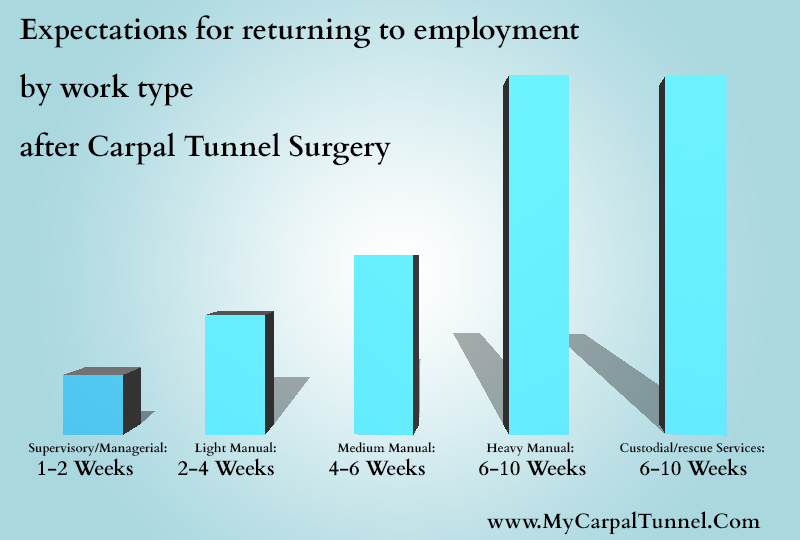
What is endoscopic carpal tunnel surgery and does it have a different recovery time?
- In an endoscopic carpal tunnel surgical procedure, two small incisions are made on either side of the Transverse Carpal Ligament or in some cases just one small incision on one side of the Transverse Carpal Ligament.
- A canula is then inserted in the incision with a slotted hole in the top side facing the ligament to be cut. The Surgeon places an endoscope up in the canula to inspect the ligament.
- The endoscope is a tiny camera connected to a monitor that the surgeon looks through to perform the surgical procedure. The surgeon wants to identify the ligament to be cut and confirm that there are no other tissues in the path of the endoscopic scalpel when it is severed.
- An endoscopic scalpel is then placed into the canula and scalpel arm is released so that when it is pull out of the slotted canula, it cuts the Transverse Carpal Ligament.
- The advantages of the endoscopic procedure is there is much less collateral damage to the major muscle groups and other soft tissue above the Transverse Carpal Ligament, so healing times are faster and the initial pain from the operation is often lower.
- Healing of the small incision are much quicker and generally take about a week. There is less chance of the small incisions reopening during recovery due to unexpected movement or a fall.
- The disadvantages of the endoscopic carpal tunnel operation are that the tendons or nerve could be scraped unintentionally when the canula is inserted in this tight space without any visual guidance. Bumping, bruising or scrapping the nerve or tendons can cause serious complications with an endoscopic operation that is performed within millimeter of the Median Nerve and the seven tendons in the Carpal Tunnel that control movement of the fingers and the overall movement of a patient’s hand.
- Tendons will generally heal from any damage over time, but it could take several months for complete healing of the tendon.
- However, any unintended bumping or scraping of the Median Nerve could cause permanent nerve damage and is a risk associated with this procedure. The prognosis for dealing with permanent damage to the Median Nerve from surgery is not good.
- If you do decide this procedure is for you, then you should employ extreme measures to identify a surgeon who has a lot of experience and has achieved a high patient rating of 5 out of 5 stars in patient reviews of surgeons performing this less invasive endoscopic carpal tunnel release procedure.
- Due to the risks associated with any surgical procedure, it is strongly suggested that all clinically documented conservative treatment be exhausted before a patient submits to the risk of a Carpal Tunnel Operation.
- The Carpal Solution Nighttime Stretching Treatment is one of the best conservative treatments that is clinically documented and has a patient rating of 4.8 out of 5 Stars in validated patient reviews. This is the type of treatment that is referred to when surgeons suggest an exhaustive effort pursuing conservative treatment before submitting to Carpal Tunnel Surgical Risks.
What is endoscopic carpal tunnel surgery and does it have a different recovery time?


Other Related Subjects on Carpal Tunnel Surgery:
What are the Risks and Potential Complications of a Carpal Tunnel Operation?
What is carpal tunnel release and does it have a different recovery time?
- Open Carpal Tunnel Release Surgery is a procedure where the surgeon makes a large incision (about 5 – 6 centimeter long) in the tissue at the base of the hand right over the Carpal Tunnel on the palm side.
- The surgeon has to sever through many layers of tissue and muscle to get access to the Transverse Carpal Ligament at the base of the hand. The Transverse Carpal Ligament is the largest ligament of the hand. It holds the many bones of the hand and wrist together firmly and is key to maintaining grip strength. The surgeon then severs the Transverse Carpal Ligament, eliminating the only wall of the Carpal Tunnel that is formed by soft tissue. The rest of the walls are made of bones. The procedure removes the pressure on the nerve.
- Open Carpal Tunnel Release Surgery can take longer to heal because so much muscle, fascia tissue and other soft tissue is cut or torn in the process of getting access to the Transverse Carpal Ligament. It is important that the tissue not be disturbed or exposed to vibrating equipment or extensive hand movement during the first 4 -6 weeks while healing takes place.
- This is also a reason a person should never have surgery on both hands at the same time. It is almost impossible to provide the rest the hands need for healing post-Carpal Tunnel Surgery, if neither hand is available for doing the basic tasks of life.
- Some people are told they can get back to work within 2 weeks of surgery. This would be a mistake, because, while some movement is good for natural healing – The Intense movement required to perform most jobs is not recommended until at least the 4 week mark and it is better to wait until after 6 weeks to begin working. Disturbing injured soft tissue leads to more scar tissue formation and can lead to more post-operational complications.
- Because surgeons are optimistic people by necessity, they tend to focus on what happens with the best-case scenarios. However, most people need to exercise extreme care during the healing process after the trauma of an Open Carpal Tunnel Surgical Procedure.
- After 8 weeks post-operation, all healing processes should be completed, unless there were complications, such as an infection.
- So, if there were no complications, full work activity can be resumed if you feel up to it.
- However, many people report that it takes up to 14 weeks to get enough grip strength and stamina to complete a full work day after a surgical procedure. Some patients report that it takes a full year before they get full use of their hands back necessary for normal life.
- There are also patients who report permanent loss of grip strength and permanent tenderness at the point of incision. Surgery of any kind is a traumatic event that should never be taken lightly.
- Everyone is different in the recovery time required. You should pay attention to your body’s signals of when it is ready to resume full activity. If you start doing things and experience pain and discomfort you should back off on the level of activity.
- Also, your Surgeon should prescribe work with a Physical Therapist post-surgery. If the surgeon does not provide this Prescription for Physical Therapy, you should request it respectfully, but firmly. Your Health Insurance will cover the costs of Physical Therapy post-surgery if the surgeon prescribes it.
- Physical Therapist and Occupational Therapist deal with people who are recovering from Carpal Tunnel every day and can help guide you to know what to do, how much is too much and provide exercises and stretching that will help speed recovery. These experienced medical professionals can also help you recognize warning signs when complications such as infection or fatigue from over-use has happened.
- While the Open Carpal Tunnel Release Surgical Procedure may take a few weeks longer to heal, there is less risks associated with complications with the Open Procedure than the complications that happen more frequently with the Endoscopic Carpal Tunnel Surgical Procedure. When the Endoscopic Procedure does not have complications, recovery times are quicker because less tissue is disturbed in reaching the Transverse Carpal Ligament.
- Sometimes Carpal Tunnel Surgery Fails. It is important to know what to do if Carpal Tunnel Surgery does fail to eliminate the pain and numbness. Some patients even report that their symptoms get worse after surgery.
- Whatever happens with Surgery do not lose hope. There are reliable treatment option you can do even after a surgery that does not go according to plan.
What is Open Carpal Tunnel Release Surgery and does it have a different recovery time?
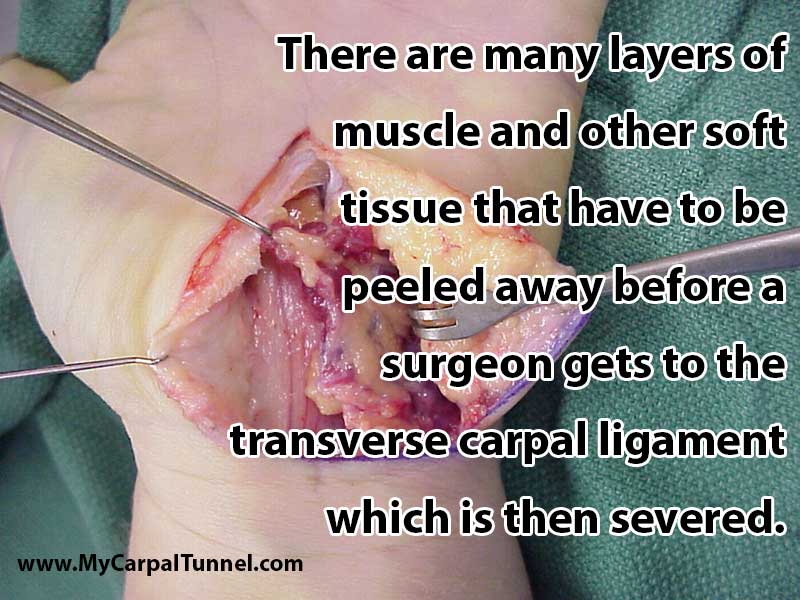
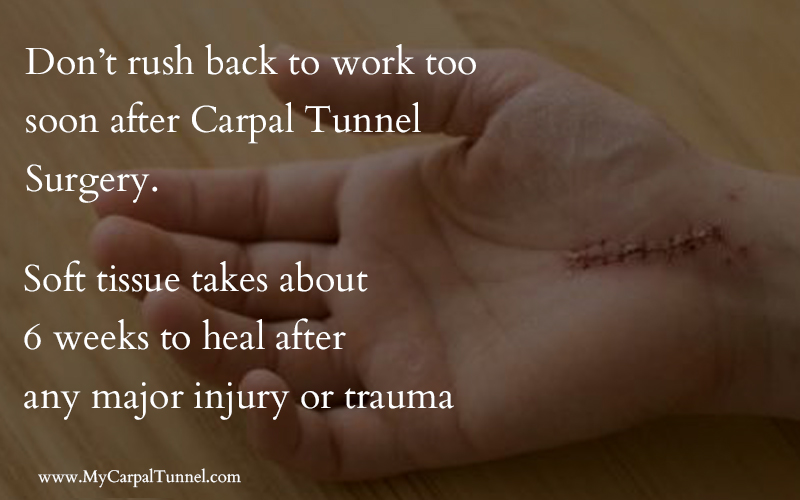

Learn More about: “How to Treat Carpal Tunnel After a Failed Surgery.”
There is still hope after Carpal Tunnel Sugery.
Whatever your situation post-surgery, do not lose hope or despair because the symptoms did not go away as you had expected and hoped. There is a non-invasive, clinically documented treatment you can turn to.
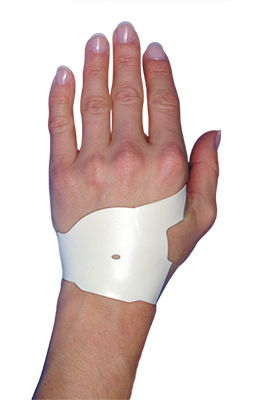
It was developed by Doctors and has a 97% success rate. It is called the Carpal Solution Therapy and has been used successfully by over 100,000 people.
Also, if you haven’t had surgery and are just looking into it. You should try the Carpal Solution before you consider the surgical procedure.
The Carpal Solution even works for people after surgery has failed. You must wait at least two months after surgery before you use the Carpal Solution Therapy.
Start getting back to your active life today without the risks, complications and recovery time associated with surgery.

Be proactive and confident about protecting your hand health, call today:
1-800-798-5210
Watch Patients tell how symptoms got worse after Carpal Tunnel Surgery until they found a natural cure.
We at First Hand Medical encourage all potential carpal tunnel syndrome sufferers to seek a accurate diagnosis from your physician while you begin using the Carpal Solution to control your symptoms.





